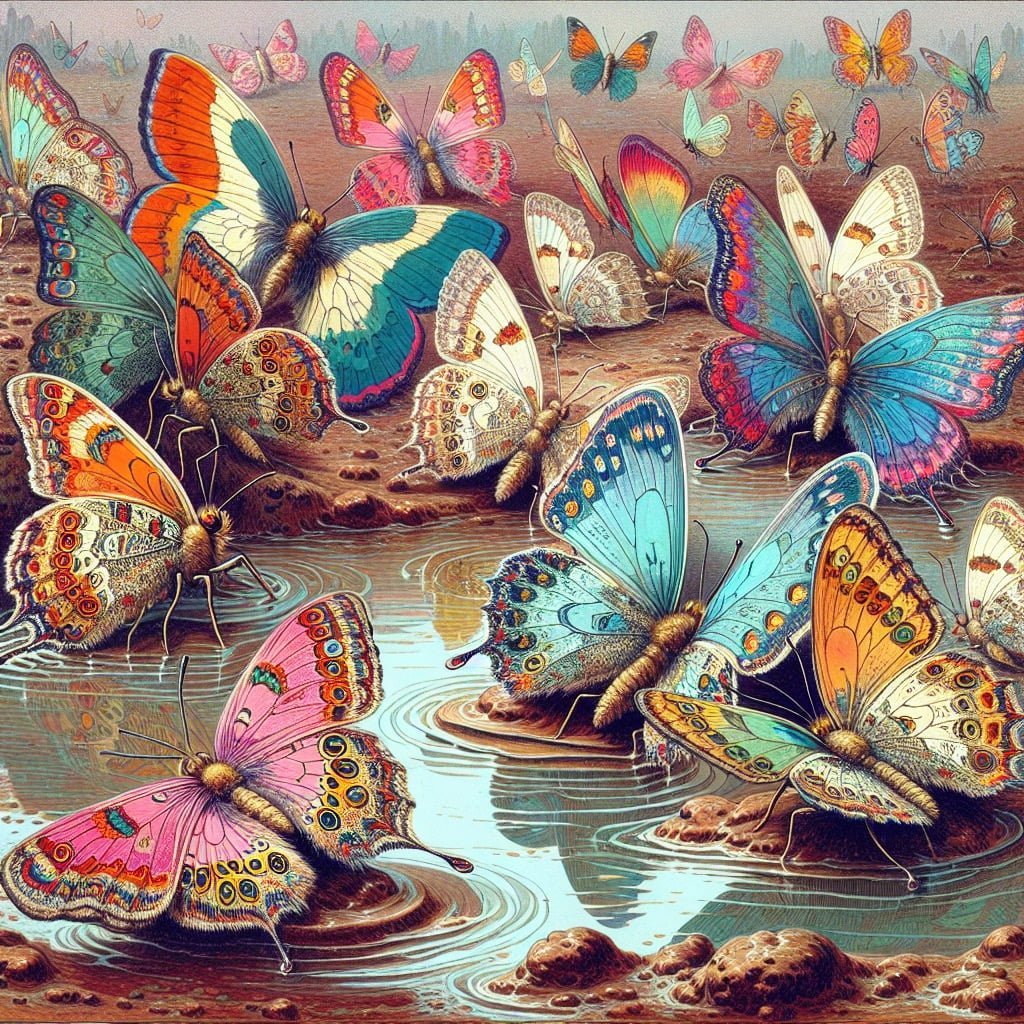Welcome to our blog where we explore fascinating **Butterfly Facts For Kids** that will surely capture the imagination of young minds! From butterflies tasting with their feet to migrating thousands of miles each year, these beautiful insects never cease to amaze us with their unique behaviors and characteristics. Whether you’re a younger kid marveling at the rainbow of colors they see or an older kid learning about their intricate wings covered in tiny scales, there’s something wondrous for everyone to discover about these delicate creatures. Join us on this enlightening journey as we uncover the captivating world of butterflies and delve into the secrets that make them truly extraordinary. Get ready to be enchanted by the kaleidoscope of wonders that await you in the magical realm of butterflies!
Butterfly Facts For Kids
1. Butterflies Taste with Their Feet

For younger kids: Butterflies can taste things by standing on them!
For older kids: Butterflies have taste sensors on their feet, allowing them to taste food sources by standing on them and determining if it’s suitable for laying eggs.
Detailed explanation:Butterflies are fascinating creatures that captivate the imagination of both children and adults. One intriguing fact about butterflies that often surprises people is that they actually taste with their feet. This may sound bizarre, but it is a unique adaptation that serves an important purpose in the butterfly’s life.
When a butterfly lands on a flower, it uses its feet to taste the flower’s nectar. The receptors on the butterfly’s feet are able to detect the presence of sugars, salts, and amino acids in the nectar, allowing the butterfly to determine whether the flower is a suitable food source. This ability to taste with their feet is crucial for butterflies to identify the right plants on which to feed and lay their eggs.
Butterflies also use their feet to explore their environment and search for potential mates. By tasting various surfaces with their feet, butterflies can gather important information about their surroundings and other butterflies in the area.
For kids who are learning about butterflies, the fact that butterflies taste with their feet can be a fun and engaging starting point for further exploration. It prompts questions about how butterflies are different from other insects and how their unique adaptations help them survive and thrive in their habitats.
In conclusion, butterflies tasting with their feet is a fascinating aspect of their biology that showcases the ingenuity of nature. By using their feet to taste, butterflies are able to navigate their world, find food, and ensure the survival of their species. It is a remarkable example of the diversity and complexity of the natural world that can inspire curiosity and wonder in both children and adults.
Butterfly Facts For Kids
2. Male Butterflies Drink from Mud Puddles for Nutrients

For younger kids: Boy butterflies drink water from mud to get good food.
For older kids: Male butterflies engage in “puddling” behavior, where they sip on minerals and nutrients dissolved in wet soil or mud to supplement their diet and reproductive success.
Detailed explanation:Butterflies are not only beautiful creatures but they are also fascinating in their behavior and habits. One interesting fact about male butterflies is that they often drink from mud puddles to obtain important nutrients for their survival. This behavior is known as “puddling” and is common among many species of butterflies.
Male butterflies need essential nutrients such as salts, amino acids, and minerals to maintain their health and reproductive capabilities. While female butterflies obtain these nutrients from nectar and other sources, male butterflies rely on mud puddles as their primary source. These mud puddles contain minerals and salts that are essential for their well-being.
But why do male butterflies specifically seek out mud puddles for nutrients? The answer lies in their reproductive needs. Male butterflies transfer these nutrients to female butterflies during mating, which in turn increases the chances of successful reproduction. By obtaining these nutrients from mud puddles, male butterflies are ensuring that they are healthy and able to pass on these essential nutrients to their mates.
Overall, the behavior of male butterflies drinking from mud puddles for nutrients is a fascinating aspect of their biology. It highlights the importance of these minerals and salts in their diet and how they have evolved to obtain these nutrients in unique ways. Next time you see a male butterfly puddling, remember that it is not just a whimsical sight but a crucial part of their survival and reproductive strategy.
Butterfly Facts For Kids
3. Monarch Butterflies Migrate Thousands of Miles Each Year

For younger kids: Monarch butterflies fly really far to find warm places to live.
For older kids: Monarch butterflies undertake a remarkable migration, traveling thousands of miles from North America to Mexico in the fall and returning in the spring, a journey spanning multiple generations.
Detailed explanation:Monarch butterflies are truly remarkable creatures that captivate the awe and wonder of children and adults alike. One particularly fascinating fact about these beautiful insects is their incredible migration journey. Every year, millions of Monarch butterflies travel thousands of miles from their breeding grounds in North America to overwintering sites in central Mexico. This phenomenon is truly a sight to behold and a testament to the resilience and adaptability of these delicate creatures.
The migration of Monarch butterflies is a strategic and complex process that spans multiple generations. The journey begins in the fall when the butterflies in North America start their long trek southward. They navigate using a combination of instinct, sun orientation, and the Earth’s magnetic field to guide them on their way. Along the journey, the butterflies face numerous challenges, including adverse weather conditions, predators, and human activities that threaten their survival.
Despite these obstacles, the Monarch butterflies press on, flying over mountains, deserts, and bodies of water to reach their final destination in Mexico. Once there, they congregate in massive colonies, clustering together in the oyamel fir forests to stay warm during the cold winter months. In the spring, the butterflies begin their journey northward once again, laying eggs along the way that will eventually hatch into the next generation of Monarchs.
The migration of Monarch butterflies is a remarkable feat of nature that showcases the resilience, adaptability, and beauty of these creatures. By learning about Butterfly Facts For Kids, we can gain a deeper appreciation for the natural world and the wonders that it holds.
Butterfly Facts For Kids
4. Butterflies See More Colors Than Humans

For younger kids: Butterflies can see way more rainbow colors than we can!
For older kids: Butterflies have an ability to see ultraviolet light, which allows them to perceive a wider range of colors than humans, helping them in finding mates and identifying flowers.
Detailed explanation:Butterflies are truly fascinating creatures, especially when it comes to their visual capabilities. One intriguing fact about butterflies is that they are able to see a wider range of colors than humans. While humans have trichromatic vision, meaning we have three types of color receptors (red, green, and blue cones) in our eyes, butterflies have pentachromatic vision. This means that they have five types of color receptors, allowing them to see a much broader spectrum of colors.
The additional color receptors in a butterfly’s eyes are able to detect ultraviolet light, which is invisible to the human eye. This ability allows butterflies to see a whole range of colors that we cannot even imagine. For example, many flowers have nectar guides that are only visible in ultraviolet light, leading butterflies directly to the nectar source. This gives them a significant advantage when foraging for food.
Butterflies use their enhanced color vision not only to find food sources but also for mating purposes. Many butterfly species have intricate patterns on their wings that are only visible in ultraviolet light. These patterns play a crucial role in mate selection and courtship rituals.
Overall, the fact that butterflies see more colors than humans is a testament to the remarkable diversity and sophistication of the natural world. Their pentachromatic vision allows them to perceive a kaleidoscope of colors that is beyond our human perception, making them truly magical creatures in the eyes of both children and adults alike. So next time you see a butterfly fluttering by, take a moment to appreciate the incredible visual world that they inhabit.
Butterfly Facts For Kids
5. A Group of Butterflies is Called a Kaleidoscope

For younger kids: Lots of butterflies together make a group called a Kaleidoscope!
For older kids: When you see a group of butterflies fluttering together, it’s known as a “kaleidoscope”, showcasing the beauty and diversity of these fragile insects.
Detailed explanation:Butterflies are fascinating creatures that capture the imagination of both children and adults alike. One interesting fact about butterflies that many people may not be aware of is that a group of butterflies is called a kaleidoscope. This term perfectly encapsulates the colorful and mesmerizing nature of these delicate insects as they flutter and dance through the air.
A kaleidoscope of butterflies can be a truly breathtaking sight, with dozens of vibrant wings shimmering in the sunlight. These groups often gather in areas with abundant flowers and nectar, such as meadows, gardens, and parks. Watching a kaleidoscope of butterflies flit from flower to flower, feeding and pollinating, is not only visually stunning but also serves as a reminder of the important role these insects play in our ecosystem.
For children, learning about butterfly facts can be both educational and enjoyable. Understanding that a group of butterflies is called a kaleidoscope can spark their curiosity and encourage them to observe these creatures in their natural habitat. By observing butterflies, children can learn about the life cycle of these insects, from egg to caterpillar to chrysalis to adult butterfly.
In conclusion, the fact that a group of butterflies is called a kaleidoscope highlights the beauty and wonder of these creatures. Whether seen in a garden or flying through a meadow, butterflies never fail to enchant us with their grace and charm. So, next time you see a kaleidoscope of butterflies fluttering by, take a moment to appreciate the magic of nature’s own living works of art.
Butterfly Facts For Kids
6. Butterfly Wings Are Covered in Tiny Scales

For younger kids: Butterfly wings have lots of tiny scales that make them pretty.
For older kids: Butterfly wings are adorned with thousands of tiny scales that create colors and patterns, much like shingles on a roof, contributing to their unique and delicate beauty.
Detailed explanation:Butterfly wings are truly remarkable structures that play a crucial role in the life of these beautiful insects. One intriguing fact about butterfly wings that is often overlooked is that they are covered in tiny scales. These scales are incredibly small, overlapping like shingles on a roof, and give butterfly wings their unique texture and coloration. In fact, it is these scales that create the intricate patterns and vibrant hues that we see on the wings of butterflies.
The presence of scales on butterfly wings serves several important purposes. Firstly, they provide insulation, helping to regulate the butterfly’s body temperature. This is especially important for butterflies, as they are cold-blooded creatures that rely on external sources of heat to warm up their bodies and become active. The scales on their wings help to retain heat and keep their bodies at an optimal temperature for flight and other activities.
Secondly, the scales on butterfly wings also play a role in aerodynamics. By creating a smooth surface, the scales reduce drag and turbulence as the butterfly flies through the air. This allows butterflies to maneuver more efficiently and conserve energy during flight.
In addition to their functional benefits, the scales on butterfly wings also serve a decorative purpose. They reflect and refract light, creating iridescence and shimmering effects that can deter predators or attract mates. The intricate patterns and colors produced by these scales are a key part of the butterfly’s defense mechanisms and mating rituals.
In conclusion, the fact that butterfly wings are covered in tiny scales is a fascinating aspect of these enchanting insects. The presence of scales on their wings not only contributes to their striking beauty but also plays a crucial role in their survival and behavior.
Butterfly Facts For Kids
7. Butterflies Can Fly at Different Speeds

For younger kids: Butterflies can fly fast or slow depending on where they’re going!
For older kids: Butterflies have the ability to fly at various speeds, ranging from slow, leisurely flights while feeding to quick, darting movements while evading predators or during courtship displays.
Detailed explanation:One fascinating fact about butterflies is that they have the ability to fly at different speeds. This is due to the intricate design of their wings, which allows for flexibility and maneuverability in the air. Butterflies are incredibly light and delicate creatures, which allows them to soar effortlessly through the sky. Despite their fragile appearance, butterflies are actually quite skilled flyers.
One reason why butterflies can fly at different speeds is due to their wing structure. The wings of a butterfly are covered in tiny scales that overlap like shingles on a roof. These scales not only give the wings their vibrant colors and patterns but also help with flight. By adjusting the angle and position of their wings, butterflies can control their speed and direction in flight.
Butterflies are also able to fly at different speeds depending on their size and species. Larger butterflies tend to be stronger fliers and can cover longer distances at faster speeds. Smaller butterflies, on the other hand, may flutter more gently and gracefully through the air. Each species of butterfly has evolved its own unique flying capabilities, allowing them to thrive in their specific habitats.
In conclusion, the fact that butterflies can fly at different speeds showcases the incredible adaptability and agility of these beautiful insects. Whether they are flitting from flower to flower or embarking on a long migration journey, butterflies demonstrate remarkable precision and control in their flight. Observing butterflies in motion is not only a treat for the eyes but also a testament to the wonders of nature. Butterfly Facts For Kids are not only educational but also inspiring, encouraging children to marvel at the beauty and intricacy of the natural world.
Butterfly Facts For Kids
8. Some Butterflies Migrate Across Continents

For younger kids: Some butterflies travel really, really far, even to other continents!
For older kids: Certain butterfly species engage in long-distance migrations that span continents, with some traveling incredible distances to find suitable breeding grounds or escape harsh climates.
Detailed explanation:Butterfly migration is a fascinating phenomenon that many species exhibit, including some butterflies that migrate across entire continents. This incredible journey is essential for the survival of these butterflies, as they often travel long distances in search of suitable breeding grounds, food sources, and ideal habitats.
One of the most well-known examples of continent-wide butterfly migration is the monarch butterfly. Every year, millions of monarch butterflies make a journey from North America to Mexico, covering thousands of miles. This migration is crucial for their survival, as the monarchs cannot tolerate the cold winter temperatures in their northern habitats. By migrating to warmer climates, they are able to survive and reproduce, ensuring the continuation of their species.
In addition to the monarch butterfly, there are many other species of butterflies that migrate across continents. These migrations are often triggered by seasonal changes, food availability, and weather patterns. Some species may also migrate to avoid predators or find new opportunities for mating and breeding.
Butterfly migration is a complex behavior that involves a combination of innate instincts and learning from previous generations. Some butterflies are able to navigate using the Earth’s magnetic field, the position of the sun, and even landmarks along their migration route. This incredible ability to navigate across vast distances is a testament to the remarkable adaptation and resilience of these beautiful insects.
In conclusion, butterfly migration across continents is a fascinating and essential aspect of their life cycle. By understanding and appreciating the incredible journeys that butterflies make, we can better appreciate the delicate balance of nature and the importance of conservation efforts to protect these magnificent creatures. So, next time you see a butterfly fluttering by, remember the amazing journey it may have taken to get there.
Butterfly Facts For Kids
9. Butterflies Can Taste Plants with Their Proboscis

For younger kids: Butterflies use a long straw to taste plants and flowers.
For older kids: Butterflies utilize their elongated proboscis, which acts like a straw, to taste plants for nectar by sensing the presence of sugars, amino acids, and salt content before feeding on them.
Detailed explanation:Butterflies are not only beautiful creatures to admire, but they also have some fascinating abilities that make them unique in the animal kingdom. One such ability is their method of tasting plants with their proboscis.
The proboscis is a long, tube-like appendage that butterflies use to drink nectar from flowers. However, it is also used for another important function – to taste plants. When a butterfly lands on a leaf or flower, it will unfurl its proboscis and use it to sample the plant’s chemical composition. This allows the butterfly to determine if the plant is a suitable source of food for either themselves or their caterpillars.
Butterflies have taste receptors located on their proboscis, which are able to detect different chemical compounds in the plants they sample. This helps them differentiate between toxic and non-toxic plants, ensuring that they only consume substances that are safe for them.
This unique ability of butterflies to taste plants with their proboscis has evolved as a crucial survival mechanism. By being able to discern the quality of plants before consuming them, butterflies are able to avoid poisoning themselves and can thrive in their environments. It also allows them to be selective in their food choices, ensuring that they are obtaining the necessary nutrients for their survival and reproduction.
In conclusion, the fact that butterflies can taste plants with their proboscis showcases the incredible adaptations that these insects have developed over time. It is an essential skill that aids in their survival and ability to thrive in diverse habitats. Kids who are interested in Butterfly Facts For Kids will surely be amazed by this unique aspect of butterfly behavior.
Butterfly Facts For Kids
10. Some Butterflies Have Wingspan of Up to 12 Inches

For younger kids: Imagine a butterfly as big as a ruler—it’s real!
For older kids: Certain butterfly species, like the Queen Alexandra’s birdwing, boast an impressive wingspan of up to 12 inches, making them one of the largest butterflies in the world and a sight to behold in their natural habitats.
Detailed explanation:One of the fascinating Butterfly Facts For Kids is that some butterflies have an impressive wingspan of up to 12 inches. This fact highlights the incredible diversity in size and shape among different butterfly species. The wingspan of a butterfly is typically measured from the tip of one wing to the tip of the other when the wings are fully extended.
The large wingspan of certain butterflies serves important purposes in their survival and reproduction. For example, a larger wingspan can allow a butterfly to glide more efficiently and cover greater distances during migration. Additionally, some butterfly species with large wingspans may use their size as a defense mechanism against predators, as it can make them appear more intimidating or harder to capture.
It’s important for kids to learn about the impressive diversity in the natural world, including the wide range of sizes and shapes found in butterflies. This fact can spark curiosity and appreciation for the beauty and complexity of these delicate creatures. By understanding and appreciating butterfly facts, kids can develop a deeper connection to nature and a desire to protect these important pollinators.
In conclusion, the fact that some butterflies have wingspans of up to 12 inches is a captivating example of the remarkable diversity in the insect world. By exploring Butterfly Facts For Kids, children can learn about the incredible variety of shapes, sizes, and behaviors found in these enchanting creatures.
Did you know?
Did you know that some butterflies taste their food by sensing the vibrations of molecules on plants with their feet?
Summary of Butterfly Facts For Kids
In this engaging and informative blog post, readers will discover ten fascinating facts about butterflies that are sure to captivate kids of all ages. From learning about how butterflies taste with their feet to understanding the incredible migration patterns of monarch butterflies, this post covers a wide range of intriguing butterfly behaviors and characteristics. Did you know that a group of butterflies is called a kaleidoscope? Or that some butterflies have wingspans of up to 12 inches? These fun and educational tidbits not only spark curiosity but also provide a deeper appreciation for these delicate and beautiful insects. Whether you’re looking to entertain younger kids with simple yet captivating facts or engage older kids with more detailed explanations, this blog post is a treasure trove of butterfly knowledge that will leave readers eager to learn more. Don’t miss out on exploring the wonderful world of butterflies with this delightful and colorful collection of butterfly facts for kids!
Sources and additional information for Butterfly Facts For Kids
WikipediaBritannicaSan Diego Zoo KidsThe Smithsonian InstitutionDK Find Out!Australian MuseumWorld Wildlife FundThe Nature ConservancyAnimal PlanetMonterey Bay AquariumPBS NatureSmithsonian’s National Zoo & Conservation Biology InstituteWorld Wildlife FundAnimal Diversity Web (University of Michigan)IUCN Red List of Threatened SpeciesThe Cornell Lab of Ornithology – All About BirdsNational Audubon SocietyEncyclopedia of LifeSeaWorld Parks & EntertainmentAustralian Museum – AnimalsEncyclopedia of Life




